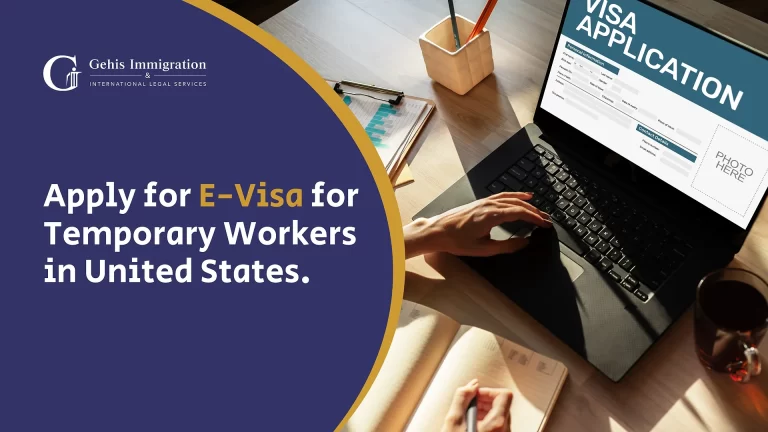In the ever-changing worldwide employment market, the E-visa category is a sign for temporary workers looking for work in the United States. This category, which includes E-1 for treaty traders and E-2 for treaty investors, provides access to various temporary job opportunities. Individuals seeking professional opportunities in the United States must understand the E-visa application process. This article aims to provide a concise yet complete overview of the E-visa category, emphasising the importance of the application process with clarity and precision. Temporary workers can arm themselves with the knowledge needed to embark on a successful and gratifying professional enterprise in the United States by delving into the complexities of this visa option.
What is the E-Visa Category?
The E-visa category is an important entry point for temporary workers who want to offer their talents and knowledge to the lively environment of the United States. This category, which includes the E-1 visa for treaty traders and the E-2 visa for treaty investors, provides various options for persons seeking short-term work in the United States.
The E-visa category is designed expressly to expedite the entry of foreign persons engaged in significant commerce or investment activities with the United States. The E-1 visa falls under this category and is intended for treaty traders who conduct international trade between their native country and the United States. The E-2 visa, on the other hand, is designed for treaty investors who invest a large amount of capital in a U.S. enterprise.
What are The Eligibility Criteria for Temporary Workers?
To qualify for the E-visa category as a temporary worker, individuals must meet specific criteria outlined by U.S. immigration authorities. Eligibility often depends on demonstrating a qualifying relationship between home and U.S. through trade or investment, and proving intent to engage in substantial trade or investment.
What is The Distinction between E-1 and E-2 Visas?
While the E-1 and E-2 visas fall under the E-visa category, they serve distinct purposes. The E-1 visa facilitates the exchange of goods, services, and technology between treaty countries, fostering international trade. Conversely, the E-2 visa centres around individuals who invest substantially in U.S. enterprises, promoting economic growth through foreign capital infusion.
What are The Advantages of E-Visa for Temporary Workers?
The professional journey in the United States as a temporary worker through the E-visa category brings forth many advantages, enhancing the experience and opportunities for individuals seeking short-term employment. Understanding these advantages is crucial for applicants aiming to make the most of their temporary work stint in the U.S.
- One of the primary advantages of the E-visa for temporary workers lies in its flexibility. E-visa holders are free to engage in various temporary employment opportunities, making it an ideal choice for those seeking diverse professional experiences in the United States. This flexibility allows individuals to try various industry landscapes, fostering personal and professional growth.
- Unlike certain visa categories operating under annual quotas, the E-visa category does not impose such limitations. This lack of an annual cap ensures eligible applicants have a consistent and unrestricted way of securing their temporary worker visa. This advantage streamlines the application process, providing a reliable avenue for qualified individuals seeking temporary employment opportunities in the U.S.
- The E-visa category doesn’t just offer a temporary foothold in the U.S.; it presents the potential for longer-term engagements. Temporary workers under the E-visa category may explore the option of visa extensions based on their continued eligibility. This allows individuals to prolong their stay and continue contributing their skills and expertise to U.S. businesses, creating a seamless bridge between short-term projects and more extended professional commitments.
What is The Application Process For E-Visa?
The application process for the E-visa as a temporary worker is a crucial step towards realising your professional aspirations in the United States. Below are a few outlines of the application process’s key components, ensuring a comprehensive and seamless journey.
Before understanding the application process, consider key factors such as your eligibility, the specific E-visa category (E-1 or E-2) applicable to your situation, and the nature of your intended trade or investment activities in the U.S. Understanding these foundational elements will set the stage for a focused and successful application.
Initiate the application process by completing the Online Nonimmigrant Visa Application form. This comprehensive form gathers essential information about your background, intended stay, and purpose for seeking the E-visa. To ensure the consular officer’s evaluation of your eligibility, it’s crucial to provide accurate and complete information in this form.
Once the Form is submitted, the next step involves paying the required visa application fee. Payment processes may vary based on the U.S. embassy or consulate handling your application. Follow the specified payment instructions and retain the payment confirmation for reference.
After completing the form and paying the fee, schedule a visa interview at the U.S. embassy or consulate in your home country. The interview is crucial for the application process, allowing you to present your case and be assessed for eligibility. Schedule the interview well in advance, considering any potential processing times.
What Are The Potential Challenges in E-Visa, and How Do We Address Them?
The journey of applying for an E-visa for temporary work in the United States may encounter challenges. Awareness of these potential hurdles and understanding how to address them is essential for a smooth and successful application process.
Common Challenges Faced During the E-Visa Application Process:
- Complexity of Documentation
- Demonstrating Substantial Trade or Investment
- Legal Nuances
Strategies for Addressing Requests for Additional Documentation:
- Thorough Preparation
- Consult with Immigration Professionals
- Open Communication with Consular Officers
How Can Legal Assistance Help in E-Visa Application?
The E-visa application journey as a temporary worker involves a complex legal landscape. Accessing legal assistance and reliable resources ensures a seamless and successful application process.
The E-visa application process involves intricate legal nuances. Seeking legal advice ensures a comprehensive understanding of eligibility criteria, documentation requirements, and potential challenges, enhancing the overall application strategy.
Every applicant’s situation is unique. Legal professionals can provide personalised guidance tailored to individual circumstances, addressing specific concerns and optimising the application for success.
Legal professionals can help applicants navigate potential pitfalls, reducing the risk of errors that could lead to delays or denials. Their insights contribute to a more robust and well-prepared application.
The E-visa application process benefits significantly from legal assistance. Seeking guidance from immigration attorneys ensures a nuanced understanding of the legal landscape






